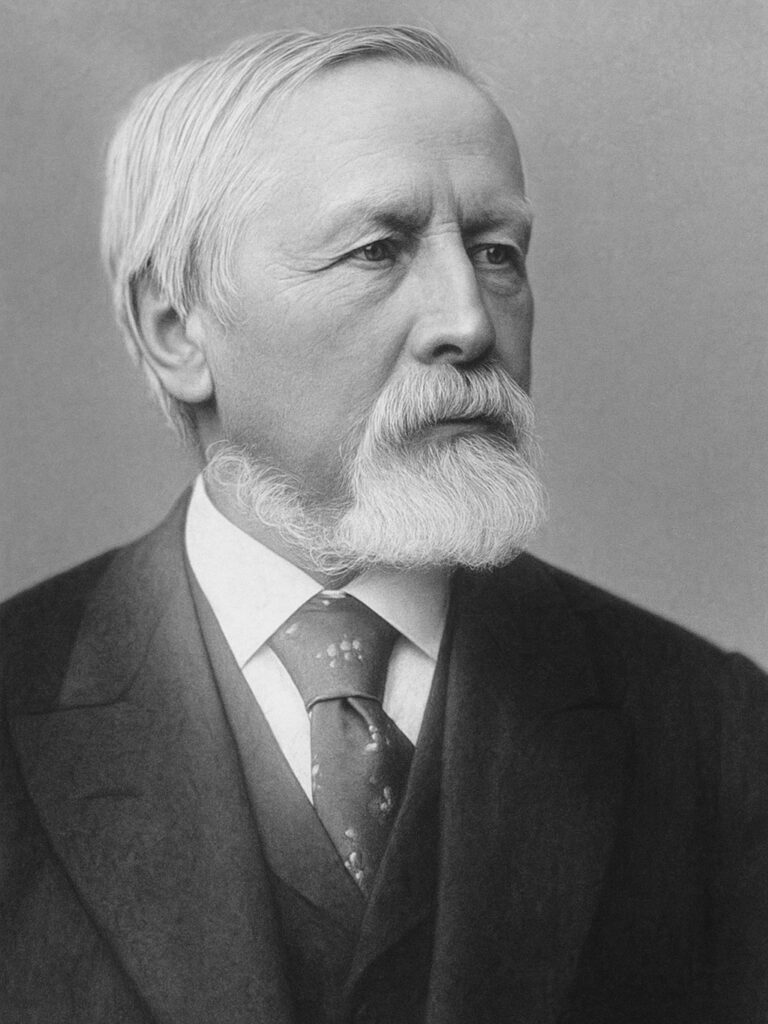Adolph Kussmaul

Adolph Kussmaul (Adolf Kußmaul) (1822-1902) was a German physician.
Foremost German physician and gastroenterologist, Kussmaul was also a poet and is considered co-author of Biedermeier literature.
Best known for “Kussmaul’s air hunger” of the diabetic patient in acidotic coma; his classical descriptions of periarteritis nodosa (“Kussmaul’s disease”), progressive bulbar paralysis, and “Kussmaul’s aphasia” of psychoses. He was the first to diagnose mesenteric embolism, and first to attempt oesophagoscopy and gastroscopy
The development of the ophthalmoscope began with the recognition of the need for the instrument, credit for which goes to Adolf Kussmaul. He was the first to research systematically a way toward viewing the fundus of the living eye, and the first to build an instrument to this end.
My ophthalmoscope was the best in the world for there existed only one – mine, its only disadvantage was that one could not see with it. It was the best ophthalmoscope at the time. Its only drawback was that it did not work
Biography
- Born on February 22, 1822 in Graben, Germany. Son to Philip Jacob Kussmaul (physician)
- 1840-1845 Studied medicine at Heidelberg
- 1843 – Working with Maximilian Joseph von Chelius (1794-1896) in the Heidelburg eye clinic. Gold medal for dissertation ‘Die Farbenerscheinungen im Grunde des menschlichen Auges’. Constructed the first ophthalmoscope (which didn’t actually work…). In 1850 Helmholtz highlighted the issue – illumination – finding that the light source should be located between the patient’s and the observer’s pupils
A planoconcave lens was made so that its concavity matched the convexity of the cornea (somewhat similar to a Hruby lens). Looking into the eye with this lens, nothing was perceived. Since the lens was greatly minifying, Kussmaul thought of enlarging the image by adding a convex lens as an ocular. He placed the two lenses in a tube, creating in effect an inverted Galilean telescope, and this was the first instrument primarily designed for ophthalmoscopy.
Mark HH, 1970
- 1845-1848 Assistant to Karl von Pfeufer (1806-1869) in Heidelberg; further studies in Vienna and Prague
- 1848-1849 Baden military surgeon rising to the rank of the rank of chief physician during the campaign against Denmark in Schleswig-Holstein
- 1850-1853 Private practice in Kandern, Schwarzwald
- 1855 – MD, University of Würzburg with “Untersuchungen über den Einfluss, welchen die Blutströmung auf die Bewegungen der Iris und andrer Theile des Kopfes ausübt.“; habilitated in Heidelberg
- 1857 – Professor of Medicine, Heidelberg
- 1859 – Professor of Medicine, Erlangen
- 1863 – Professor of Medicine, Freiburg im Breisgau
- 1866 – Described a systemic necrotizing vasculitis with inflammation of small or medium-sized muscular arteries (Periarteritis nodosa). The condition was first detailed in 1852 by Karl von Rokitansky (1804-1878) and is now more commonly termed Polyarteritis nodosa (PAN)
- 1876 – Professor of Medicine, Strassburg
- 1877 – First to describe dyslexia – Kussmaul called it ‘word blindness’; developed the term – Poliomyelitis
- 1886 – Retired; emeritus Professor at Strassburg; Badian Privy Counsellor and honorary citizen of Heidelberg.
- Died on May 28, 1902 in Heidelberg
Medical Eponyms
Kussmaul disease (1866) [Kussmaul-Maier disease] – polyarteritis nodosa
Kussmaul sign (1873) [Kussmaul pulse]
Paradoxical increased jugular venous pressure (JVP) with inspiration, associated with RV constriction (pericarditis) and COPD
Kussmaul respiration (1874) [Kussmaul air hunger; Kussmaul breathing]
Kussmaul’s original description would appear to be of gasping breaths, with reduced frequency, seen only in the latter stages of severe metabolic acidosis
Kussmaul coma – (1874) [archaic] diabetic coma
Kussmaul aphasia of psychoses (1877)
Voluntary mutism, which sometimes occurs in psychiatric conditions. [archaic] selective mutism
Major Publications
- Kussmaul A. Die Farbenerscheinungen im Grunde des menschlichen Auges. 1845
- Kussmaul A. Untersuchungen über den Einfluss, welchen die Blutströmung auf die Bewegungen der Iris. Würzburg. 1855
- Kussmaul A. The nature and origin of epileptiform convulsions, caused by profuse bleeding and also those of true epilepsy. London: New Sydenham Society. 1859
- Kussmaul A. Zwei Fälle von Paraplegie mit tödtlichem Ausgange ohne anatomische nachweisbare oder toxische Ursache [Two cases of paraplegia with fatal outcome without anatomical demonstrable or toxic cause]. Reichard. 1859 [Guillain-Barré Syndrome]
- Kussmaul A. Untersuchungen über das Seelenleben des neugeborenen Menschen. Leipzig. 1859
- Kussmaul A. Untersuchungen über den constitutionellen Mercurialismus und sein Verhältniss zur constitutionellen Syphilis. Würzburg: Stahel. 1861
- Kussmaul A, Maier R. Über eine bisher nicht beschriebene eigenthümliche Arterienerkrankung (Periarteritis nodosa), die mit Morbus Brightii und rapid fortschreitender, allgemeiner Muskellähmung einhergeht. Deutsches Archiv für klinische Medicin. 1866; 1: 484-518 [Kussmaul disease]
- Kussmaul A. Rheinschwäbisch. Humoristische Gedichte vom Verfasser “des weiland Gottlieb Biedermaier.” 1968
- Kussmaul A. Über schwielige Mediastino-Perikarditis und den paradoxen Puls. Berliner klinische Wochenschrift, 1873; 10(37): 433-435 [Kussmaul sign, pulsus paradoxus]
- Kussmaul A. Zur Lehre vom Diabetes mellitus. Über eine eigenthümliche Todesart bei Diabetischen, über Acetonämie, Glycerin-Behandlung Diabetes und Einspritzungen von Diastase in Blut bei dieser Krankheit. Deutsches Archiv für klinische Medicin. 1874;14:1-46. [Major RH. A peculiar mode of death in diabetes (translation) In: Classic Descriptions Of Disease. 1945: 245-249 ][Kussmaul respiration]
- Kussmaul A. Die Störungen der Sprache: Versuch einer Pathologie der Sprache. Leipzig: Vogel 1877 [Kussmaul aphasia]
Fun Facts
Alternate spelling: German literature ‘Adolf’ or ‘Adolph’ and surname as ‘Kussmaul’ or ‘Kußmaul’
Along with long time friend and lawyer Ludwig Eichrodt (1827-1892) Kussmaul published a number of poems between 1855 and 1857, under the pseudonym ‘Gottlieb Biedermaier’. The phrase ‘Biedermeier’ used to describe the literacy period 1815-1848 of which the style of his poems were typical.
References
Biography
- Editorial: Adolf Kussmaul (1822-1902) – Country doctor to clinical professor. JAMA 1964;189:58-59.
- Johnson SK et al. Adolf Kussmaul: Distinguished Clinician and Medical Pioneer. Clin Med Res. 2009;7(3):107-112
- Loriaux DL. Adolf Kussmaul: 1822–1902. The Endocrinologist. 2010;20(3):95
- Rehnberg V, Walters E. The life and work of Adolph Kussmaul 1822-1902: ‘Sword swallowers in modern medicine‘. J Intensive Care Soc. 2017 Feb;18(1):71-72
- Bibliography. Kussmaul, Adolf 1822-1902. WorldCat Identities
Eponymous terms
- Mark HH. The first ophthalmoscope? Adolf Kussmaul 1845. Arch Ophthalmol 1970; 84: 520-521
MB BCh BAO from Queens University, Belfast.
